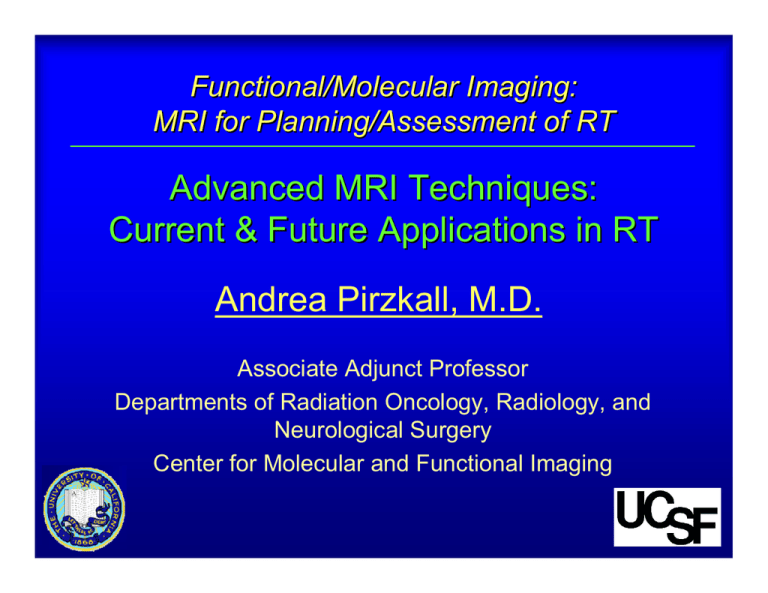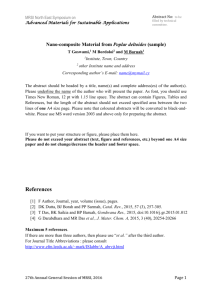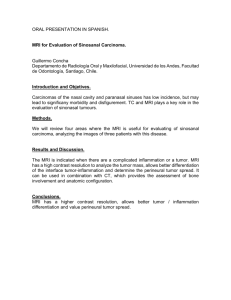Andrea Pirzkall, M.D. Advanced MRI Techniques: Current & Future Applications in RT
advertisement

Functional/Molecular Imaging: MRI for Planning/Assessment of RT Advanced MRI Techniques: Current & Future Applications in RT Andrea Pirzkall, M.D. Associate Adjunct Professor Departments of Radiation Oncology, Radiology, and Neurological Surgery Center for Molecular and Functional Imaging Imaging in RT ? Issues of Interest.. 1. Subregions, -volumes? (GTV, BTV) • Target definition 2. Margins? (CTV) 3. Lymph nodal involvement; distant spread? • Treatment Response • Predictors of outcome 1. Treatment effect or tumor recurrence? 2. Surrogate for therapeutic effectiveness? aMRI for RT at UCSF • 2 major disease sites – Brain gliomas – Prostate cancer Brain Gliomas - Glioblastoma Multiforme (GBM) - Background • Most malignant type of brain tumor in adults • Standard of care: surgery, radiation therapy, concurrent chemotherapy (Temozolomide) – Median survival 15 mos * – RT: 3D-CRT, 60 Gy/30 Fx (2 Gy/day); >80% local failure • Newer, molecularly targeted and/or antiangiogenic, agents increasingly added to standard therapy and tested in clinical trials • Early assessment of therapy response is critical but often hindered by questionable changes in morphological appearance * Stupp R, NEJM 2005 Brain Gliomas – Characteristics & Challenges T1w post Gad SPGR T2w FSE T1w SPGR pre-surgery, at initial diagnosis • • Infiltrative Spatially heterogeneous → difficulty to define treatment margins and/or plan focal therapy • DSC Tumor vessels are structurally and functionally abnormal SWI at 7T → impairs delivery of therapeutic agents → creates abnormal microenvironment (e.g. hypoxia) that reduces effectiveness of RT and CHT Brain Gliomas - Challenges • Monitoring/assessing response to therapy Initial scan Treatment effect or Tumor recurrence? → Pseudo-progression Follow-up Contrast enhancement represents an area of BBB breakdown, and may not be synonymous with tumor progression or angiogenesis. Brain Gliomas - Challenges • Patient selection Predictive measures? Survival 15.1 months Survival 32.3 months Can non-invasive MR measurements provide surrogate markers for biologic behavior and patient outcome (survival, time-to-progression) ? MR Imaging Tools & Modalities • Advanced MRI techniques prove valuable to assess the metabolic and physiologic aspects of brain and tumor tissue: – 3D Proton Magnetic Resonance Spectroscopy Imaging (MRSI) – Perfusion weighted Imaging (PWI) – Diffusion weighted Imaging (DWI) • @ UCSF: Brain tumor SPORE imaging protocol 2002 – 2007, renewed 2007-2012 3D 1H Magnetic Resonance Spectroscopy Imaging (MRSI) Parameters: 1. Metabolites: 1Cho, 2Cr, 3NAA, 4Lip, 5Lac 2. Metabolic Indices: Assesses metabolic status of brain and tumor tissue based on measurements of cellular metabolites that reflect the biological behavior of each respective volume compartment CNI, CrNI, CCrI MRSI: Metabolic Indices, i.e. CNI Cho Cr NAA normal Cho tumor CNI measures the increase in Cho, decrease in NAA relative to normal Perfusion Weighted Imaging (PWI) Signal Intensity Assesses overall cerebral blood volume, tissue micro-vasculature and angiogenesis as well as vessel permeability injection Peak Height → Angiogenesis Recovery → Vessel leakiness time (sec) time (sec) CBV Perfusion Weighted Imaging (PWI) Perfusion Imaging with DSC (T2*) and DCE T1W Post-Gd T1W fBV * Zierhut M, et al, ISMRM 2006 T2*W rCBV T1W KPS T2*W %Rec Diffusion Weighted Imaging (DWI) T1w post Gad T2w EP ADC FA Assesses water diffusivity in brain tissue which has been used to - infer changes in cellularity, cell membrane permeability, and extra-cellular space ⇒ Apparent Diffusion Coefficient (nADC) - and structural integrity ⇒ Fractional Anisotropy (nFA) (normalized to normal appearing white matter, NAWM) Diffusion Tensor Imaging (DTI) • DTI sensitive to anisotropic or directionally dependent diffusion, describes 3D diffusivity of water ⇒ to measure and tract fiber orientation (esp in large WM tracts) Photo of cadaver brain from Visible Human Project, NLM DTI color map of axonal fiber orientation Vector plot of primary eigenvector → describes orientation of axonal bundles Diffusion Tensor Imaging (DTI): Structure Avoidance • DTI Fiber tracks match cortical mapping • Motor pathways tracked from cortex to midbrain Tumor Red: shoulder motor Blue: wrist motor Yellow: overlap * Berman JI, et. al., Journal of Neurosurgery. 2004. aMRI in RT: Results so far.. 1. Target definition • Spatial extent • Spatial heterogeneity • Pattern of recurrence 2. Treatment response • Treatment effect or tumor recurrence • Surrogate for therapeutic effectiveness • Radiation changes in normal tissue 3. Prediction of outcome • Survival • Time-to-progression • Focal failure Target Definition Spatial Extent Discordance according to MRI/MRSI T2h MRI: 48 cc 8 mm MRSI: T2 hyperintensity CNI 2 Contrast Enhancement CNI 3 CNI 4 CNI 2 : T2 8 cc 12 cc 5 cc CE * Pirzkall A, et al. IJROBP 2001 10 mm 14 mm 18 mm 29 cc CNI 2 : CE 15 cc 15 cc CNI 3 : CE 10 cc CNI 4 : CE Treatment margins? Pattern of Recurrence post 3D-CRT relative to pre-RT MRI/MRSI • • • Clinical example: Increasing CE during FU residing within pre-RT MRI/S and 60 Gy pre-RT 7 mos post RT Increased CE during FU occurred within the combined MRI/MRSI volume as defined at pre-RT in 8/9 patient Normal tissue exposure to 60 Gy nearly double that of the MRI/MRSI volume (median 78.5 cc vs 38.8 cc, respectively) * Park I, et al. IJROBP 2007 Treatment margins? - Early Delayed RT Changes • Radiation changes in normal appearing brain tissue Cho / NAA (median) 0.75 0.70 (a) < 25 Gy 25-50 Gy > 50 Gy Also, vessels in NAWM become leaky and have decreased rCBV 2 months after XRT 0.65 0.60 0.55 Pre-RT Post-RT 2 mo. 4 mo. 6 mo. → Dose dependent increase in Cho/NAA ratio & vessel permeability * Lee M. J Magn Reson Imag 2004 Treatment margins? - Late Delayed RT Changes• Radiation changes assessed at high field strength MRI (7T) – Astrocytoma ° III, 5 yrs post therapy (60 Gy CRT + 6 cycles BCNU) Tumor site Surrounding & “Normal” tissue Spatial heterogeneity MRSI CNI CCrI 13 CrNI LLI 0 Spatial heterogeneity MRI vs MRSI vs PWI MRSI Tumor with high Cho & high Cr Tumor with high Cho & low Cr Necrosis PWI rCBV < NAWM Increased vasculature Difference between the spatial distribution of regions with increased metabolism (high Cho) and those with increased rCBV Target Definition? Guiding RT Delivery: IMRT CNI 2 CTV (FLAIR + CNI2) CNI 3 CNI 4 GTV (CNI3,4 + CE) 72 Gy 60 Gy 30 Fx MRI T1w post Gad + MRSI IMRT treatment plan Predictors of outcome & Treatment Response Predictors of worse survival @ pre-surgery pre-surgery MRI PWI DWI MRSI (56 pts) Volume none Parameter ↑ vol% CEL/T2all ↑ vol% Nec/T2all ↓ 25% ADC/T2all ↑ Lac & Lip/T2all * Crawford F, et al. ISMRM 2006 Predictors of worse survival @ pre-Tx pre-Tx (70 pts) MRI PWI DWI MRSI Volume CEL, NEL, T2all rCBV>3 ADC<1.5 CNI>2 Lac>0.25 Parameter ↑ rCBV (75, 90%)/NEL ↑ Lac (max, 75, 90%)/NEL * Saraswathy S, et al. ISMRM 2007 Predictors of worse survival @ prior to surgery & prior to adjuvant therapy pre-surgery MRI PWI DWI MRSI (56 pts) pre-Tx (70 pts) Amount residual functional tumor left behind is critical !! Volume none CEL, NEL, T2all rCBV>3 ⇐ ADC<1.5 CNI>2 Lac>0.25 Parameter ↑ vol% CEL/T2all ↑ vol% Nec/T2all ↓ 25% ADC/T2all ↑ Lac & Lip/T2all ↑ rCBV (75, 90%)/NEL ↑ Lac (max, 75, 90%)/NEL ⇑ ⇑ More malignant phenotype? Suggestive of poor response to RT and CHT (high cell density, regions of hypoxia & necrosis) Predictors of shorter Time-to-progression following surgery and adjuvant cytotoxic therapy • Temporal changes ∆ pre-/post-RT – %Recovery [within NEL] • ↑ vascular leakiness correlates with shorter TTP • @ pre-Tx – Higher peak heights of Cho and Cr as well as related indices (CNI, CCrI, CrNI) [within NEL > CEL] • suggest heightened proliferation and predict shorter TTP – Higher CBV and PH [within NEL] • Suggest increased angiogenesis and predict shorter TTP * Pirzkall A, et al. ISMRM 2007 Predictors of shorter Time-to-progression following surgery and adjuvant cytotoxic therapy High Cho and Lac prior to RT Pre-RT Post-RT Customized image-guided therapy Resection Cavity (RC) Contrast enhancement (CE) T2 hyperintensity (T2 h) 60 Gy CRT m/p low-risk volume (LRV) m/p high-risk volume (HRV) “New” target definition: LRV: rCBV>3 CTV: RC+T2h+CE+LRV ADC<1.5 BED → 2 Gy/day CNI>2 → 60 Gy → 60 Gy Lac>0.25 GTV: HRV HRV: ↑ Lac → 2.5 - 3 Gy/day ↑ CBV/PH → 72 - 90 Gy → 84-120 Gy OR: → focal therapy (RS, CED, else) Focal therapy: Image guided CED • Clinical phase I study for newly diagnosed GBM s/p GTR in preparation – CED of liposomal CPT-11 – Adjuvant RT + Temozolomide Prognostic Value of MRSI - Radiosurgery in recurrent GBM Time to further treatment Survival 100 100 (p < 0.01) 80 (p < 0.01) 80 60 A: No abnormal voxels outside treated volume (18 pts) B: Abnormal voxels outside treated volume (18 pts) 60 A 40 20 A 40 20 B 0 B 0 0 10 20 30 40 50 0 10 20 30 40 50 Patients with MRSI abnormal regions that were beyond the conventional radiosurgical target volume do worse compared to others in whom MRSI abnormality was confined to the volume treated with RS. * Graves et al. Neurosurg 2000,46(2):319-226 Guiding RT Delivery: Radiosurgery Conventional RS Target CNI > 2 Guiding RT Delivery: Radiosurgery Conventional RS Target CNI > 2 PIDL based on MRSI Treatment Effect or Tumor Recurrence? Pre-treatment 5 mos. post-GK MRI ⇒ progression, MRSI ⇒ radiation response Histology ⇒NECROSIS Chan et al, 2003 Pre-treatment 5 mos. post-GK MRI ⇒ progression, MRSI ⇒ progression Histology ⇒TUMOR Treatment Response following surgery + adjuvant cytotoxic AND cytostatic therapy • Antiangiogenic Tx – Avastin + CPT-11 • Recurrent GBM • Molecularly targeted Tx – Enzastaurin + Temozolomide + RT • Newly dx GBM → Data acquisition/evaluation ongoing – Avastin + Temozolomide +/- Tarceva (in patients stable post XRT+Temozolomide, EGRF status dependent?) • Newly dx GBM → To be launched (~6 mos) Treatment Response following surgery + adjuvant cytotoxic AND cytostatic therapy Historic • • 6 mos PFS 15% Med PFS 9 wks Avastin/ Irinotecan 30% 20 wks Q: • Anti-VEGF effect only? • Improved drug delivery? • Synergistic effects? Pre-Tx * Vredenburgh JJ, et al, Clin Cancer Res 2007 After 4 cycles of Avastin/Irinotecan aMRI in Prostate Cancer MRI/MRSI Assessment prior to Therapy Cancer Citrate Cancer vs. Healthy • • MRI: Reduced signal intensity on T2w Healthy Polyamines Choline Creatine Polyamines Creatine Choline Citrate MRSI: Increased choline and decreased citrate and polyamines on MRSI PPM 3.0 2.5 2.0 PPM 3.0 2.5 2.0 MRSI Scoring System for Prostate Peripheral Zone Abnormalities Step-section histopathological tumor maps were used to identify MRSI voxels of unequivocally benign (n = 306) or malignant (n = 81) peripheral zone tissue in 22 patients with MRI/MRSI studies prior to radical prostatectomy. 1 2 definitely healthy probably healthy PPM 3.0 2.5 2.0 • • PPM 3.0 2.5 2.0 3 equivocal PPM 3.0 2.5 2.0 4 5 probably cancer definitely cancer PPM 3.0 2.5 2.0 PPM 3.0 2.5 2.0 The score is based on primarily on the choline+creatine/citrate ratio Secondarily on choline/creatine ratio, levels of citrate, polyamines and spectral S/N Jung JA, Radiology 2004; 233:701-708 Use of MRSI for Radiation Planning • • • • (1) (2) (3) (4) IMRT RS PPI (seeds) HDR Int. J. Radiat. Oncol. Biol. Phys. 1999; 44:921-929; Int. J. Radiat. Oncol. Biol. Phys. 2000; 47:1085-1096; Int. J. Radiat. Oncol. Biol. Phys. 2002; 52:429-438; Int. J. Radiat. Oncol. Biol. Phys. 2004; 59:1196-1207. Use of MRSI for Radiation Planning - HDR - An average of 2 DIL’s were contoured on CT images based on concordant MRI/MRSI findings MRI planning scan with the HDR catheters in place, manually aligned with a MRI/MRSI staging exam Pouliot, Int J Radiat Oncol Biol Phys 2004; 59:1196-1207. Dose to DIL >120%, while simultaneously treating the entire prostate (100%) w/o increasing the dose to surrounding normal tissues MRSI Assessment following Therapy After therapy, difficult to detect cancer based on MRI alone Atrophy Healthy polyamine Cho Cr PPM 3.0 2.5 2.0 Citrate PPM 3.0 2.5 2.0 Cancer Cho Cr Citrate PPM 3.0 2.5 2.0 Biomarker of Therapeutic Failure - Elevated Choline Cancer Radiation atypia Choline Creatine The presence of three or more abnormal voxels with choline/ creatine >1.5 demonstrated a sensitivity and specificity of 87% and 72%, respectively, and an overall accuracy of 81% for the diagnosis of local recurrent/residual disease. Coakley, Radiology 2004; 233:441-448. Biomarker of Effective Therapy - Metabolic Atrophy - • • Increasing metabolic atrophy paralleled decreasing serum PSA with time after Brachytherapy and EBRT, but occurred significantly earlier. The presence of residual abnormal metabolism did not correlate with PSA in individual patients after radiation. Pickett B et al, IJROBP 59(3):665-73, 2004. Pickett B et al, IJROBP 60(4):1047-55, 2004. Time Course of Metabolic Atrophy % of voxels 100 w/ metabolic atrophy Brachytherapy: 144 Gy (N = 39) EBRT: 74 - 81 Gy (N = 29) 80 Brachytherapy was associated with an earlier more dramatic decrease in prostate metabolism than EBRT resulting in an significantly larger % of the prostate demonstrating metabolic atrophy at the 6-12 and 13-24 month time points 60 * p < 0.05 * * 40 20 0 Pre-Therapy Pickett B et al, IJROBP 65(1):65-72, 2006 6 -12 13 -24 25 - 48 Time after Radiation Therapy (months) > 48 (mean -53) Time to Resolution of Metabolic Abnormality Proportion of Patients 1 .75 .5 .25 0 • • Brachytherapy (N = 39) EBRT (N = 29) 0 12 24 36 Months from Treatment 48 60 The median time to resolution of abnormalities for Brachytherapy patients was 24.8 mos, 7.4 mos sooner than for EBRT patients (32.2 months). All patients receiving Brachytherapy had resolution of metabolic abnormalities by 60 mos, while 10% of patients receiving EBRT still had metabolic abnormalities at 60 mos. Pickett, B., Int J Radiat Oncol Biol Phys, 2006 Summary • There are many new MR methods that are likely to impact the diagnosis and management of patients with cancer. • These methods give information about changes in tissue structure and function rather than merely anatomy. • They can be acquired as an add-on to a conventional anatomic MR exam being used for treatment planning or follow-up. • Quantitative analysis and integration of the results from multiple parameters are critical aspects of this technology. • Validation of the biological significance of these parameters requires correlations with histology and outcome. Acknowledgements - UCSF Prostate Imaging Program MR Scientists Radiology John Kurhanewicz, Ph.D. Dan Vigneron, Ph.D. Mark Swanson, Ph.D. Sarah J. Nelson, Ph.D. Susan Noworolski, Ph.D. Albert Chen, BS Samson Jarso, BS Mark Alpers, B.S. Akpene, BS Penny Wood, BS Kristin Wright, BS Beverly Fein, RN Saying Li, MD Tuan-Khanh Tran, Ph.D. Josh Star-Lack, Ph.D. Lucas Carjaval, BS Niles Bruce, R.T. Evelyn Proctor, R.T. Fergus Coakley, MD Aliya Qayyum, MD Jeff Hom, Bs Ullrich Muller-Lisse, MD Kyle Yu, MD Juergen Scheidler, MD Urology Peter R. Carroll, MD Katsuto Shinohara, MD Eric Small, MD Biostatistics Vivian Weinberg, Ph.D. Ying Lu, Ph.D. Cancer Center Chris Haqq Robert Bok, Ph.D. M.D. Mark Schuman, Ph.D. Radiation Oncology Stanford Mack Roach, MD Jean Pouliet, Ph.D. Barbie Pickett, Ph.D. Joe Hsu, MD Randy Ten-Haken, MD Youngbok Kim, Ph.D. John Pauly, Ph.D Chuck Cunningham, Ph.D Pathology Jeff Simko, MD Lars Schmitt Laura Tabatabai, MD GE Health Ralph Hurd, Ph.D Doug, Kelley Pom Sailasuta,Ph.D. Susan Kohler, Ph.D. NIH Funding R01 CA079980-06 Acknowledgements - UCSF Brain Imaging Program Surbeck Laboratory Neurosurgery Radiation Oncology Sarah J. Nelson, PhD Tracy R. McKnight, PhD Esin Ozturk, PhD Michael Lee, PhD Janine Lupo, MS Forrest Crawford, MS Il Woo Park, MS Colleen McGue, BS Suja Saraswathy, MS Mitchel Berger, MD Michael McDermott, MD Michael D. Prados, MD Susan Chang, MD Kathleen Lamborn, PhD Krystof Bankiewicz, PhD Lynn J. Verhey, PhD David Larson, MD, PhD Penny Sneed, MD William Wara, MD Jean Nakamura, MD Radiology William P. Dillon, MD Soonmee Cha, MD Grant support P50 CA97297 RO1 CA-59-880 R21 CA110171 UC Discovery Grants LSIT01-10107 and ITL-BIO04-10148 funded in conjunction with GE Healthcare






